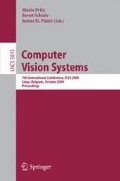Abstract
We present a system, which is able to track multiple objects under partial and total occlusion. The reasoning system builds up a graph based spatio-temporal representation of object hypotheses and thus is able to explain the scene even if objects are totally occluded. Furthermore it adapts the object models and learns new appearances at assumed object locations. We represent objects in a star-shaped geometrical model of interest points using a codebook. The novelty of our system is to combine a spatio-temporal reasoning system and an interest point based object detector for on-line improving of object models in terms of adding new, and deleting unreliable interest points. We propose this system for a consistent representation of objects in an image sequence and for learning changes of appearances on the fly.
The work described in this article has been funded by European projects under the contract no. 6029427, no. 215821 and no. 216886, as well as by the Austrian Science Foundation under the grant #S9101 and #S9104 (“Cognitive Vision”).
Access this chapter
Tax calculation will be finalised at checkout
Purchases are for personal use only
Preview
Unable to display preview. Download preview PDF.
References
Gredebäck, G.: Infants Knowledge of Occluded Objects: Evidence of Early Spatiotemporal Representation. Number Dissertation, Acta Universitatis Upsaliensis; Faculty of Social Sciences (2004) ISBN 91-554-5898-X
Spelke, E.S., von Hofsten, C.: Predictive reaching for occluded objects by 6-month-old infants. Journal of Cognition and Development 2(3), 261–281 (2001)
Elgammal, A.M., Davis, L.S.: Probabilistic framework for segmenting people under occlusion. In: ICCV, pp. 145–152 (2001)
Huang, Y., Essa, I.: Tracking multiple objects through occlusion. In: IEEE Conference on Computer Vision and Pattern Recognition (CVPR 2005), San Diego, CA, USA, June 2005, vol. 2, pp. 1051–1058 (2005)
Brémond, F., Thonnat, M.: Tracking multiple non-rigid objects in video sequences. IEEE Transaction on Circuits and Systems for Video Technology Journal 8(5) (september 1998)
McKenna, S., Jabri, S., Duric, Z., Rosenfeld, A., Wechsler, H.: Tracking groups of people. Computer Vision and Image Understanding 80(1), 42–56 (2000)
Bennett, B., Magee, D.R., Cohn, A.G., Hogg, D.C.: Using spatio-temporal continuity constraints to enhance visual tracking of moving objects. In: ECAI-2004, pp. 922–926 (2004)
Matsuyama, T., Hwang, V.S.: SIGMA: A Knowledge-Based Aerial Image Understanding System. Perseus Publishing (1990)
Cucchiara, R., Piccardi, M., Mello, P.: Image analysis and rule-based reasoning for a traffic monitoring system. IEEE Transactions on Intelligent Transportation Systems 1(2), 119–130 (2000)
Agarwal, S., Awan, A., Roth, D.: Learning to detect objects in images via a sparse, part-based representation. IEEE Transactions on Pattern Analysis and Machine Intelligence 26(11), 1475–1490 (2004)
Leibe, B., Leonardis, A., Schiele, B.: Robust object detection with interleaved categorization and segmentation. Int. J. Comput. Vision 77(1-3), 259–289 (2008)
Lowe, D.G.: Distinctive image features from scale-invariant keypoints. International Journal of Computer Vision 60(2), 91–110 (2004)
Lourakis, M.: homest: A c/c++ library for robust, non-linear homography estimation (July 2006), http://www.ics.forth.gr/~lourakis/homest/ (Accessed on 20 July 2006)
Author information
Authors and Affiliations
Editor information
Editors and Affiliations
Rights and permissions
Copyright information
© 2009 Springer-Verlag Berlin Heidelberg
About this paper
Cite this paper
Prankl, J., Antenreiter, M., Auer, P., Vincze, M. (2009). Consistent Interpretation of Image Sequences to Improve Object Models on the Fly . In: Fritz, M., Schiele, B., Piater, J.H. (eds) Computer Vision Systems. ICVS 2009. Lecture Notes in Computer Science, vol 5815. Springer, Berlin, Heidelberg. https://doi.org/10.1007/978-3-642-04667-4_39
Download citation
DOI: https://doi.org/10.1007/978-3-642-04667-4_39
Publisher Name: Springer, Berlin, Heidelberg
Print ISBN: 978-3-642-04666-7
Online ISBN: 978-3-642-04667-4
eBook Packages: Computer ScienceComputer Science (R0)

